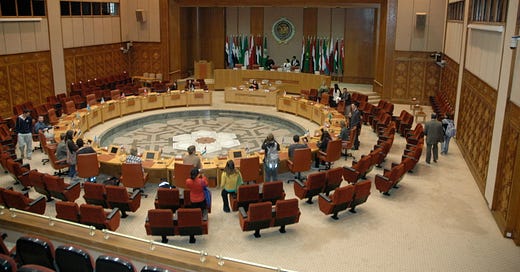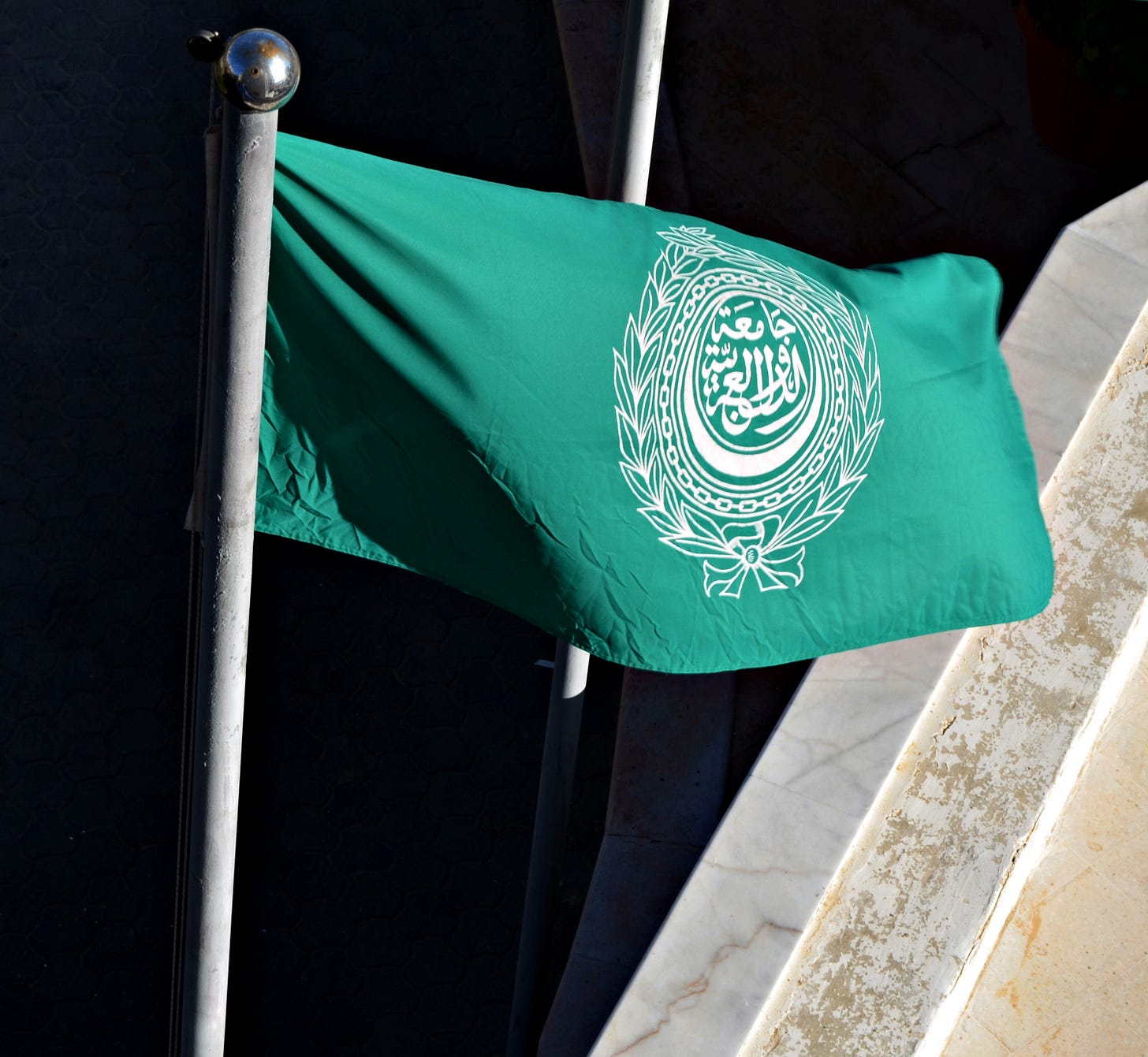Stone the crows! The Arab League has suddenly found the motivation to formulate its own plan for Gaza in the wake of Donald Trump’s plan to relocate its population and turn it into an American riviera.
Regional leaders have proposed to build about 200,000 new homes in the Strip. Leaked documents from a summit in Cairo suggest that they have taken inspiration from the Trump plan and are now pledging a luxury development but without first displacing the civilian population.
In the 112-page document, the Egyptian government showed off AI-generated images of housing estates, parks and community facilities, with plans for an impressive harbour technology centre, beachfront hotels and an airport.
The plan, endorsed on Tuesday, proposed to place Gaza under the transitional authority of a technocratic committee of Palestinians, supposedly not affiliated to any political factions — ha! — but under the umbrella of a “Palestinian government”, presumably the weak, inept and rejectionist Ramallah regime.
Egypt’s Abdel Fattah El-Sisi said that his country would train the Palestinian forces who would be in charge of security, replacing Hamas which has ruled since 2007. So we can all rest easy, then.
This plan will doubtless satisfy many liberals in the West who simply want to be sold a nice Arab dream that avoids moving Palestinians abroad for a better life (even though many of them would like nothing better) and props up the El Dorado of the two-state solution. That’s all that matters. Their children aren’t going to suffer the fallout and in a few years, when Gaza collapses again into corruption, incompetence, blood and tears, they can simply blame the Israelis.
To those with less superficial concerns, however, the plan seems rather less convincing. To put it mildly.
For one thing, how are these politically-neutral, responsible Palestinian technocrats going to be found? Anybody involved with the existing Ramallah regime is corrupt and incompetent at the very least, and most of them hold violence in the same positive regard as their abysmal, rabble-rousing president, who continues to pay rewards to those convicted of terrorism, despite claims to the contrary.
Moreover, in a profoundly tribal and factional society riddled with competing political groups, most of which have an armed wing, the idea of recruiting clean new leadership is little more than a conjuring trick for the gullible. If the Egyptians are recruiting these bureaucrats, they will immediately do so based on their own murky interests and those of the men involved at every level of the system. This has been one of the central problems dogging the peace process for decades.
When it comes to corruption, Egypt ranks jointly with Sierra Leone, 108th out of 180 countries in the world, according to Transparency International. From Israel’s point of view, the problem of corruption is about more than just money. It offers Islamists like Hamas an opening to advance their interests by paying people off.
For years, Egypt has ducked difficult questions about the way it has kept its border sealed to Gazan refugees (unless they are able to pay at least $5,000 a head) and turned a blind eye to the tunnels burrowing from its sovereign territory into Rafah, one of the main conduits through which Hamas received its arms.
Indeed, it was more than simply a case of blind eyes. Egyptian military elites have enriched themselves by facilitating this trade, quietly keeping Hamas’s lifeline open while supposedly maintaining security cooperation with Israel, with which they have signed a peace agreement. Extending such an arrangement into Gaza, which seems overwhelmingly likely, is hardly a recipe for keeping jihadis out of the picture and Israeli communities safe.
Egypt, of course, is economically dysfunctional, with the Houthi attacks in the Red Sea restricting inward investment. A food security crisis is growing, the combined result of Covid lockdowns, the Ukraine war, mounting debt, dwindling currency reserves and collapsing exchange rates. It also faces deep problems with Islamism.
Studies by the Egyptian Family Health Survey have found that 86 per cent of married women between 15 and 49 have suffered female genital mutilation. All this casts rather a different light on Cairo’s complaints about Israeli “genocide” over the past 17 months, and rather places its leadership of this new Gaza initiative in question.
Although the other Arab states are not in exactly Egypt’s position, they all suffer versions of the same problems, aside from the Gulf states which benefit from a steady stream of petrodollars. Thus, the problem with the plan is that it rests upon rotten foundations of corruption, extremism, incompetence and unsavoury political agendas.
There is nothing inherent in Palestinians that condemns them to live under either death cults or repressive regimes. Rather, this has been engineered by both regional Arab powers and the liberal international community.
Instead of absorbing or supporting the 700,000 refugees from 1948 — who alone among the many millions of displaced people at the time, from India to Europe and the Middle East, were deprived the right to move on with their lives — their Arab neighbours kept them penned up in their enclaves without hope of a future. Why? To create structural pressure on Israel that would eventually lead to its collapse.
After careful lobbying and manoeuvres by the Soviet Union and the Arab states, the United Nations joined this agenda, created a specific agency, UNRWA, for handling Palestinian refugees, while all others are supported by the United Nations High Commissioner for Refugees (UNHCR).
Whereas most refugees were helped to build new lives elsewhere, the Palestinians were intentionally kept in downtrodden limbo, sold a “return” to Israel as the only solution to their problems. That partly explains why the great towns and villages of the West Bank and Gaza are persistently called “refugee camps”, even though they lie in Palestinian land. Nobody seemed to notice the contradiction.
Audaciously, the UN changed the rules for the Palestinians, allowing refugee status to be handed down through the generations. This meant that the 700,000 refugees of 1948 have grown to more than five million today (unlike the 900,000 Jews expelled from the Middle East in the same period). Once again, nobody seemed to notice.
Moreover, unlike all other cases, Palestinians did not lose their refugee status even when they had settled elsewhere, meaning that Bella Hadid, for example, the American model of Palestinian extraction, is still technically a “refugee”. If this measure was applied universally, much of the world would qualify for UN handouts.
As a result, those claiming to be “refugees” thus amount to more than half the existing population. What would happen to democratic Israel if they were allowed in? In this way, the moral-sounding “right of return” for Palestinians places Israel in a position of either appearing belligerent by refusing or signing its own death warrant by accepting.
All of this conspires to keep those benighted people as a source of political pressure on the Jewish state, intended to destabilise it over the long term and foster structural contradictions that can only be resolved by its destruction, at the expense of the wellbeing of the Palestinians themselves.
Frankly, it is all a massive stitch-up. The latest Arab plan for Gaza is simply an extension of the same project. While the West looks on the proposal and sees visions of two states existing peacefully side-by-side, the Arab regimes view it simply as a stepping-stone along the path towards Israel’s demise, a reward for October 7.
It comes from the same instinct that led the Palestinian leadership to repeatedly rejected the two-state solution. Last week, former Israeli prime minister Ehud Olmert disclosed for the first time the map of the peace offer he made to Mahmoud Abbas back in 2008.
It offered offered a state on 94 per cent of the West Bank with 6 per cent of Israeli territory to make up the difference, together with East Jerusalem, an internationally administered Old City, a tunnel connecting the West Bank and Gaza, and a thousand Palestinian refugees accepted by Israel annually for five years, with financial compensation for the rest.
Abbas rejected it for the same reason as a State of Palestine was turned down in 1948. Palestinian leaders base their identity upon the rejection of Israel rather than the self-determination and flourishing of their people.
This is the great tragedy of the region. It is what has led 2025 to witness a society that is dominated by those who fetishise death, men who have expended great energy in indoctrinating generation after generation, often in UN-funded schools with the tacit complicity of the international community. Not everybody in Gaza has been radicalised; but it remains the most radicalised society on Earth. Resolve that problem and peace would immediately arise.
All of which gives the Arab plan for Gaza a rather different complexion. As Oren Marmorstein, a spokesman for the ministry of foreign affairs, put it, the proposal “fails to address the realities of the situation following October 7 2023, remaining rooted in outdated perspectives”. Quite.
I’m not arguing that the Trump plan is perfect, or easy, or legally straightforward, or even practicable. I’m not trying to needlessly undermine proposals or promote the status quo. All I’m saying is that the briefest consideration of the history and the underlying political agendas reveals this plan to be part of the same old con.






Declaration to 3 yes
The Egyptian report is just a cut and paste from existing sources which does nothing to really tackle the underlying issue - the 100 desire to wipe Jews out of the region. The first step is to reverse Khartoum